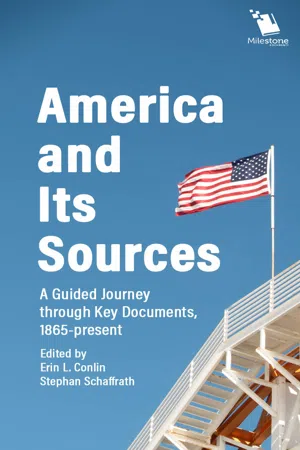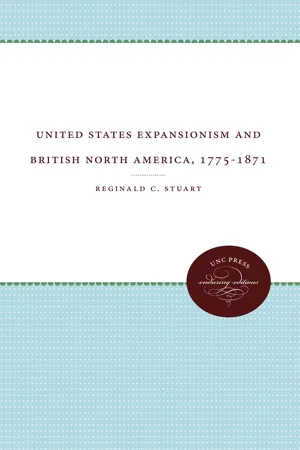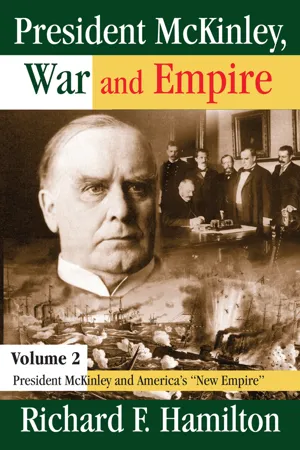History
Westward Expansion
Westward Expansion refers to the period in American history during the 19th century when the United States expanded its territory westward. This expansion was driven by factors such as economic opportunities, the desire for land, and the belief in Manifest Destiny. It led to the acquisition of new territories, conflicts with Native American tribes, and the eventual settlement of the western frontier.
Written by Perlego with AI-assistance
Related key terms
3 Key excerpts on "Westward Expansion"
- eBook - ePub
America and Its Sources
A Guided Journey through Key Documents, 1865-present
- Erin L. Conlin, Stephan Schaffrath(Authors)
- 2019(Publication Date)
- Schlager Group Inc.(Publisher)
3.1 Westward Expansion and American IdentityOverviewThe readings in this unit address two different, yet related, aspects of U.S. history—western expansion and American identity. Although each topic can be studied individually, when read together they illustrate how “Americans” perceived of themselves and the land they inhabited.ExpansionNineteenth-century Americans employed the term Manifest Destiny to capture their belief that Americans were “destined” to expand the United States from coast to coast. Many Americans believed it was their right and obligation to spread American culture and Christianity throughout the continent. By the late 1890s they had achieved this goal, but it came at a great cost to native populations inhabiting western lands. As America moved into the twentieth century, it looked to expand its influence beyond the continental United States.Historian Frederick Jackson Turner developed the so-called Frontier Thesis in 1893, in response to the 1890 census. The census appeared to show that there were no more large tracts of unsettled land left in the United States. Therefore, there was no more American “frontier.” In the document “The Significance of the Frontier in American History,” Turner outlines the various ways in which the frontier shaped the nation and its people. The excerpt highlights the positive impacts settlement had on the United States in building a new nation and a new national identity. The excerpt, however, does not address the conflicts that also emerged as a result of American expansion. As several of the other readings demonstrate, American settlers were not moving into uninhabited lands. Their encounters with and treatment of Native Americans show readers today how they viewed native populations.The Dawes Severalty Act shows how the law, although somewhat well intentioned, severely limited and sometimes eradicated native people’s lives and identities. Coupled with the eyewitness accounts of the Wounded Knee Massacre, we see the brutality inflicted upon native populations by the American government and military in western territories. Native Americans’ experiences show us that even though they were “American” in the deepest sense of the word, they existed outside the boundaries and protections of citizenship. - Reginald C. Stuart(Author)
- 2004(Publication Date)
- The University of North Carolina Press(Publisher)
Southerners wanted new land because they believed that slavery must expand or else shrivel and die. They defended this institution on cultural as well as economic and constitutional grounds, but their ability to balance the objective of sustaining slavery with their goal of controlling the Democratic Party faltered in the 1850s. The South became more cohesive because of its exaggerated fears of abolitionists and free soilers, and the resulting sectional rift paralyzed the ability of the United States to admit more territories into the Union.In the North, migrants filled in around the Great Lakes and Upper Mississippi Valley. But settlers looked farther west as well. Frontier fur traders and entrepreneurs were the first to venture regularly up the Missouri Valley and across the Rockies to the Pacific Coast. Then missionaries and a handful of settlers trekked to Oregon in the 1830s. Next, larger numbers journeyed across the Oregon Trail, with some breaking off to cross the Sierra Nevada Mountains to California in the 1840s. Simultaneously, the Mormons escaped persecution by migrating to Utah, their wilderness Zion. Under Mexican sovereignty when the Mormons planned their exodus, Utah soon became American territory with the Treaty of Guadalupe Hidalgo that ended the Mexican War. Although not by design a part of America’s expansion—Mormon purpose was to escape America—the Mormons under Brigham Young soon developed expansionist designs of their own, projecting colonies down the Colorado River and into Nevada and California, as well as north into Idaho. Other motivations besides commercial interests led large groups of Americans to acquire and settle lands not part of the United States in 1815.During the 1840s, the divisions of the two-party system made the Democrats the party of continentalism. New states of the union emerged. Political expansion followed territorial acquisition, commercial ambitions, and demographic movement. Between 1815 and 1860, the American economy itself underwent dramatic growth as a result of the nation’s westward movement. This economic expansion had important implications for America’s external relations. Entrepreneurship characterized America’s antebellum period. It is true that Americans did not suddenly become entrepreneurs after 1815. After all, the dream of free enterprise had driven Englishmen across the Atlantic in the seventeenth and eighteenth centuries. But the pursuit of commerce and economic growth after the War of 1812 went far beyond what colonials or the founding fathers had envisioned. Acquisitiveness, ambition, and the knack for applying technology to manufacturing and transportation transformed the United States into the leading economic power after Great Britain. Although this growth was gradual, with booms and busts, in the antebellum period, it was real and profound. And manufacturing, along with increased food production for export, was crucial to the development of a growing global network linked by American merchantmen. These economic changes had important ramifications for relations with the British North American provinces.- eBook - ePub
President McKinley, War and Empire
President McKinley and America's New Empire
- Richard F. Hamilton(Author)
- 2017(Publication Date)
- Routledge(Publisher)
1 American Expansionism: 1763-1896Expansionism, efforts to acquire new territories, is an ever-recurring theme in American history. A review of the previous history provides some background to the events that occurred during the McKinley administration. Scores of monographs report and analyze American expansion along with hundreds of memoirs and biographies dealing with the participants. This introduction is best seen as a sketch, a brief overview of a complicated subject.This chapter also provides lessons for the analysis in the later chapters. It covers a series of episodes, some major, some minor. Some of these efforts were initiated by the president, some by members of the Congress, and some were joint ventures. In several instances, the initiative came from voluntary associations and pressure groups. In some cases, the expansionist attempt was the work of individuals, of zealous entrepreneurs. In a few instances the initiators were located outside the nation, the leaders of independent states sensing some advantages to be gained by joining the American Union.Some of these attempts were successful—as seen from the perspective of the initiators—but some were failures. Many accounts of expansionism are selective, dealing only with the successes. The resulting record of “victories” yields a false portrait of the expansionists’ power. But, as will be seen, opponents were present and active in each case, and in many instances they won the contest. The prime example—if “expansionism” had been an “irresistible force,” Canada would have become part of the United States and Alaska would be a contiguous state.1As background for this history, one should remember an important pre-revolutionary event, the 1763 Peace of Paris, which ended the Seven Years’ War. It gave Britain a vast territory, all of nouvelle France which included much of modern-day Canada and most of the land between the Appalachians and the Mississippi. That same year, to limit the costs of administering this new empire, King George III “issued a royal proclamation which established a dividing line down the crest of the Appalachian Mountains. No settlers were to locate west of that line.” But that “effort to keep the peace by separating settlers and Indians failed,” one author has written, “for trying to stop the westward movement of American colonials was like trying to make the tides stand still...”2
Learn about this page
Index pages curate the most relevant extracts from our library of academic textbooks. They’ve been created using an in-house natural language model (NLM), each adding context and meaning to key research topics.


